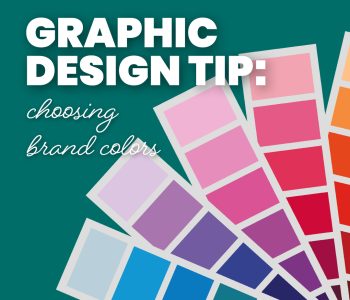
Choosing brand colors is more than just picking a pretty shade; a lot of thought and strategy takes place behind the scenes. Importantly, it’s about finding the right balance between the client’s preferences and the need to create a cohesive and effective color scheme that really works for your brand.
Client: I like pink.
Designer: Great! What kind of pink? Rose? Blush? Neon? Hot? Pastel? Bubblegum?
And so on. There is a wide range of tones and hues that are referred to as “pink,” from soft pastels to bold and bright colors, that can convey different moods and messages, depending on how they are used in design.
Your brand’s color palette typically includes both primary logo colors and supporting colors, which together create a cohesive visual identity across various platforms. Whether you’re designing business cards, creating digital ads, or developing in-store signage, the right color palette helps establish a strong and memorable brand presence, differentiating you from competitors and reinforcing your brand’s message.
Pantone Color Compatibility
Every printer produces slightly different colors because each one mixes the CMYK color model—Cyan, Magenta, Yellow, and Key (Black)—in its own way. As a result, the same color can appear in varying shades across different printers. In contrast, Pantone colors provide a standardized system, allowing you to purchase specific ink to ensure consistent results.
Pantone is a color library that offers a universal language of color, ensuring consistency across a variety of applications. Unlike CMYK that uses a combination of four inks and can yield varying results, depending on the printer, Pantone inks are single-color inks that produce reliable, consistent results across different printers. Additionally, printers commonly use Pantone swatch books to compare their test prints with the standardized colors, allowing them to adjust their output to match the desired shade accurately.
To help you visualize how your chosen Pantone colors translate to CMYK, the Pantone Bridge color book provides printed swatch comparisons, showing you the closest CMYK match to your selected Pantone shades.
Color Theory
When choosing your brand’s color palette, applying color theory can significantly enhance your ability to stand out from competitors. Color theory provides insights into how different colors interact with each other and the psychological effects they can have on consumers. By selecting colors that align with your brand’s values and help you stand out from competitors, you create a more memorable brand presence.
For example, understanding the emotional responses that colors evoke can help you select hues that resonate with your target audience. Bold and vibrant colors might attract attention and convey energy, while softer, muted tones could evoke calm and sophistication. In package design, using a unique color palette can set your product apart on crowded shelves, making it instantly recognizable and appealing.
Here are some examples of common hues and the emotions they evoke, based on color theory:
- Black: mourning, death, darkness, sophistication, luxury
- Blue: trustworthiness, peace, calm, serenity, stability
- Brown: nature, warmth, comfort, reliability, simplicity, strength, health
- Gray: neutrality, sophistication, formality, restraint, tranquility
- Green: nature, growth, harmony, peace, garden centers, anything plant-related
- Orange: energy, enthusiasm, creativity
- Pink: femininity, love, playfulness, tranquility
- Purple: royalty, power, mystery
- Red: love, energy, passion, danger, aggression
- Red, White, and Blue: politics, government
- Turquoise: calmness, creativity, wisdom, good fortune
- White: simplicity, purity, innocence, cleanliness
- Yellow: happiness, energy, optimism, fear
By thoughtfully applying color theory, you can craft a brand identity that stands out visually and creates a deeper connection with your audience.
ADA Compliance for Web
When it comes to ADA compliance for web design, which is based on the Americans with Disabilities Act, color choice directly impacts usability because the contrast ratio applies to the combination of the text color and the background color it sits on as well as the text size.
According to WCAG 2.1 guidelines from the W3C Web Accessibility Initiative, text smaller than 18px should have a contrast ratio of at least 4.5:1, while text 18px and bold should have a ratio of at least 3:1.
Although not all of your primary brand colors need to meet these web standards, it’s a good idea to have a few additional colors in your palette to create compliant combinations and to ensure accessibility for all users on your website.
The Importance of Brand Colors
Choosing the right brand colors plays a fundamental role in shaping your brand’s identity and perception. These colors are integral to your logo and also should feature prominently in your website design, printed materials, digital ads, and signage. The consistency and thoughtfulness in your color choices ensure that your brand is instantly recognizable and evokes the desired emotional response from your audience.
Looking for help with your company’s branding? Our experienced designers are here to help! Contact Green Closet Creative today to bring your vision to life.

